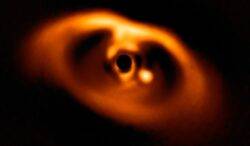PDS 70 is a star similar to our Sun, just younger and cooler (Credits: ESO/A. Müller et al.)
Astronomers have discovered water vapour in a young star system, boosting hope for potentially new habitable planets in the making.
The vapour was found in the PDS 70 protoplanetary disk, a young disk of gas and dust surrounding the star PDS 70.
It is located about 370 light-years from Earth in the constellation Centaurus. The disk is about 140 au (1.3 billion miles) in radius and is thought to be the birthplace of two planets, PDS 70b and PDS 70c.
‘PDS 70 is a star similar to our Sun, just younger and cooler – by observing it we can trace back how planets in our Solar System formed and what was their chemical composition before they were fully formed,’ said Giulia Perotti, one of the authors of the study.
‘Our result shows that water is present in the inner disk of this iconic system where planets similar to Earth may be assembling. Hence, these accreting terrestrial planets have access to a water reservoir.’
‘The detected water signal comes from the inner disk of PDS 70 (!) and not from the two giant planets and/or from terrestrial planets within its inner disk,’ said Dr Perotti.
The discovery was made using observations of PDS 70 from The James Webb Space Telescope (JWST).
JWST’s Mid-Infrared Instrument (MIRI) can be used to study the temperature and composition of the disk (Picture: GBrammer/CWilliams/ACarnall/SWNS /PA)
‘This result revealed what JWST MIRI is capable of, allowing us to pick up the weak signal of water molecules in the region where terrestrial planets form, even in faint cool disks like PDS 70,’ said Dr Perotti.
‘The next step will be to characterize the PDS 70 system with all instruments on board of JWST (this is already happening as I write) and to expand our search to more disks with large gaps to find signatures of forming planets and study their composition,’
JWST’s Mid-Infrared Instrument (MIRI) can be used to study the temperature and composition of the disk, and its Near-Infrared Camera (NIRCam) can be used to image the disk in more detail.
‘It is extremely challenging to detect terrestrial planets, especially in a planetary system in the making like PDS 70. The power of JWST coupled with high-resolution ALMA and near-infrared observations will help studying in more depth the structure of the PDS 70 inner disk and the presence of terrestrial planets there.’
MORE : ‘Mind-blowing’ discovery suggests distant planet may not be alone
MORE : Nasa’s Hubble telescope spots another ‘jellyfish’ galaxy 700,000,000 light-years away
The James Webb Space Telescope played a part.





